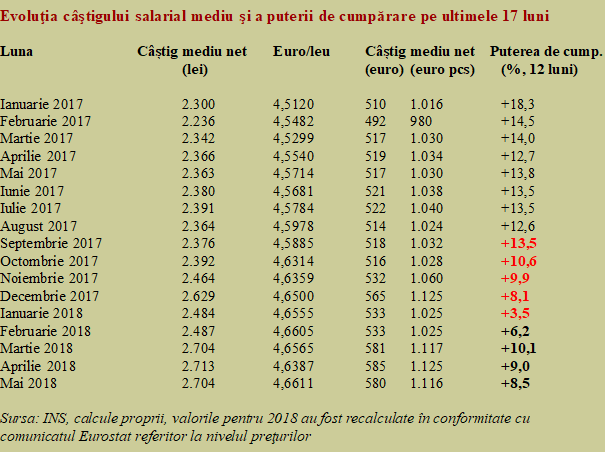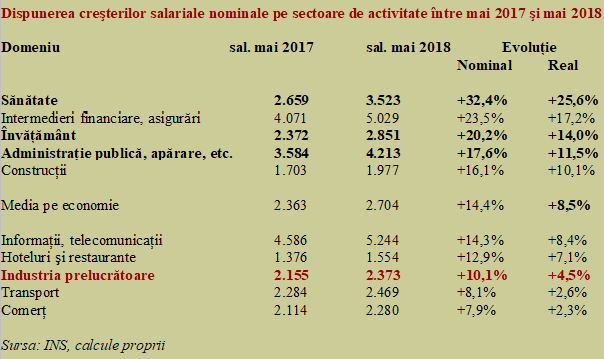The average gross wage announced by the INS for May 2018 was 4,512 lei, 0.4% lower than in the previous month. Net nominal average wage decreased by 0.3% and reached 2,704 lei, exactly the same as in March.
Given the higher euro/leu average exchange rate in the month when money was received and the change in the ratio between local prices and the EU average (52%, recently published by Eurostat), the purchasing power in euro decreased to 1,116 euros.
As a result of the inflation recorded, the wage index compared to April 2018 was only 99.2%, and the increase compared to the same month of the previous year dropped again from + 10.1% in March and + 9.0% in April, to 8.5% in May.
The real reference wage (the purchasing power of the money received expressed as an index related to October 1990) also went down on the same trend, from 195.7% in March to 195.3% in April and only 193.5% in May 2018.
*
- Evolution of average national wage and purchasing power over the last 17 months
- Month Net average wage (lei) Euro/leu Net average wage (euro) (euro pcs) Purchasing power (%, 12 months)
*
Increases by sectors – health ranks first, manufacturing sector last
By sectors, the highest wage increases were recorded in the public sector, with the health sector ranking first by far (+ 32.4% nominal and + 25.6% in real terms).
Above the education sector (+ 23.5% nominal and + 17.2% real) and the public administration (+ 17.6% and 11.6%, respectively), the financial and insurance sector slipped in (+ 23.5% and + 17.2%, respectively).
Excluding constructions (+ 16.1%, in nominal and + 10.1%, in real terms), all the other areas of activity were below the national average (obviously pulled up by the public sector), with the manufacturing sector positioned somewhere at half the salary increases in terms of purchasing power (+ 10.1% in nominal and only 4.5% in real terms).
Noteworthy, much better correlated with the GDP growth (4% gross and 4.2% seasonally adjusted on Q1 2018).
Against the background of a decreasing average wage across the economy, manufacturing sector recovered (by one percentage point) above the 90% threshold. However, that remains a clearly different positioning compared to Western economies, where wages in the manufacturing sector are, usually, above the national average.
*
- Distribution of nominal wage increases by sectors between May 2017 and May 2018
- Sector Wage May 2017 Wage May 2018 Change (Nominal Real)
- Health
- Financial intermediations, insurance
- Education
- Public administration, defence, etc.
- Construction
- Average on the economy
- IT&C
- Hotels and restaurants
- Manufacturing industry
- Transport
- Trade
*
Purchasing power growth values in the transport and trade sectors dropped to relatively low levels (2.6% and 2.3%, respectively), namely far below the potential given by the economic growth, and are at the bottom of the list at the level national.
All in all, the distribution of benefits of the economic growth does not seem to be fair, as these sectors are placed at only one-fifth of the advance in the wage registered by the public administration.












